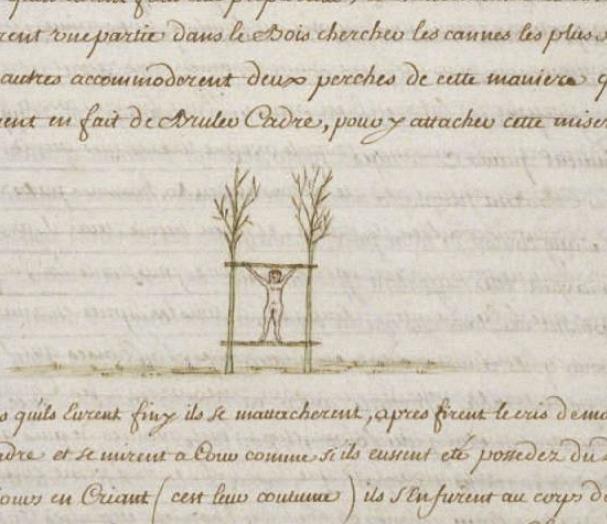Condoned Torture and Revenge in Eighteenth-Century New Orleans January 22, 2014
Author: Beach Combing | in : Modern , trackback***Warning this post has some very unpleasant material: if you are having a bad day, do yourself a favour and just click away…***
‘The west’, that monolith to which most readers of this blog belong, has gradually over the centuries, shied away from torture. But there are moments in history when societies return on themselves and take up again practices that parents and grandparents would have found abhorrent. Take the horrific killing of an Indian woman at New Orleans 10 April 1730. The woman, of the Natchez people, was brought to the French in the city by a Tunica delegation – the Tunica were an allied Indian tribe. The Tunica had captured her and five other Natchez in the previous weeks. She was, then, offered to the governor by the Tunica as a diplomatic gift but the governor refused. The Tunica next took the woman outside the governor’s house (the fate of the other Natchez is unclear) and near the Indian encampments she was placed on a frame and then made to suffer ‘the slow fire’.
Here the poor wretch was tied and burnt with their ceremonies, before the whole city, who flocked to witness the spectacle. She was burnt first on one side, then on the other, all down the body, but during that long and cruel torture she never shed a tear. On the contrary, she seemed to deride the unskilfulness of her tormentors, insulting them, and threatening that her death would soon be avenged by her tribe.
This author explains how the inhabitants of the city came to witness this extremely unpleasant act en masse: at a date when public executions were rarely so prolonged in France itself. What he does not say is that some of the French actually partook in the torture. French women came and ‘larded’ the Indian captive, poking her with sharp sticks so that fat ran out of her cooked body. And one French soldier cut flesh from the woman’s genitals and devoured this flesh before her. What had happened to people who would normally never have indulged in these kinds of acts, who, in fact, had, in part, defined the sauvages beyond the city walls as being heartless torturers against the reason and civilisation of La France?
The answer is that several had been through hell. In late November 1729 a Natchez uprising had overwhelmed French colonists living in Lousiana. That uprising had been provoked by stupidities and cruelties on the side of the French settlers and the revenge of the Natchez was terrible. Perhaps over two hundred colonists were killed in battle and after in the terrible orgies of pain that followed on. One example from a catalogue of horror must suffice: a pregnant woman was made to eat her ears nose and lips; her child was cut from her belly and decapitated before her; the child was placed back in her belly that was sewn back up; then Natchez braves urinated in what was left of her mouth before burying her alive.
No modern reader could condone the acts of the French but it needs to be understood that those who partook had been victims of the Natchez attack and had extremely strong feelings: the same cannot be said for most of those who turned out to watch. The victim in question was not either, ‘just another Indian’, she was the wife of a Natchez chief and she had personally ordered the killing of three French men after the uprising. What, on earth, though was the French governor doing allowing this sort of inexcusable barbarity to be practised or to go unpunished on his watch? Incredibly, it seems to have been deliberate calculation. By refusing the gift or prisoners it was understood that the Tunica would murder the Indian woman in their own way. And this seems to have had more potential to satisfy the populace than a trial and a French execution.
There are other cases when French in New Orleans used the Indians to sate their own barbarous desire. July 9 of the same year several Indian enemies were burnt by a party of allied Bayagoulas and Colapissas just outside the city: the Governor again having refused them as a gift. But at the same time there were limits on the vicaristic or even personal savagery that the French could be allowed to experience. The woman who ‘larded’ the Indian woman were not mentioned in any subsequent report, but the cannibal soldier was court martialled and made to run the gauntlet.
Other examples of government condoned torture later on in history: drbeachcombing AT yahoo DOT com contemporary instances, of course, are all too well testified and are all too depressing. For an early example of a society turning back on its own customs in antiquity follow this link…
The source for this article is an excellent piece by Sophia White in the William and Mary Quarterly 70 (2013 July)



